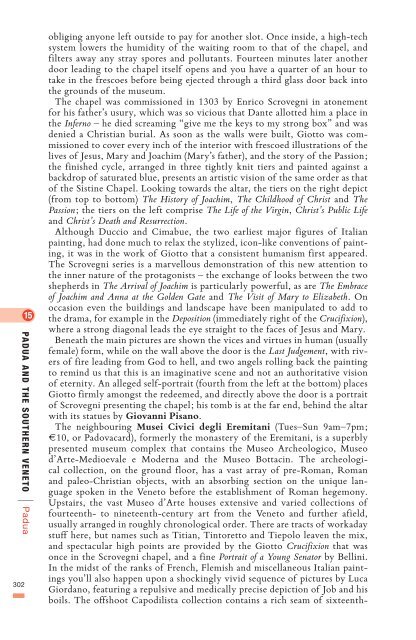Create successful ePaper yourself
Turn your PDF publications into a flip-book with our unique Google optimized e-Paper software.
302<br />
Padua <strong>and</strong> <strong>the</strong> sou<strong>the</strong>rn vene<strong>to</strong><br />
| Padua<br />
obliging anyone left outside <strong>to</strong> pay for ano<strong>the</strong>r slot. Once inside, a high-tech<br />
system lowers <strong>the</strong> humidity of <strong>the</strong> waiting room <strong>to</strong> that of <strong>the</strong> chapel, <strong>and</strong><br />
filters away any stray spores <strong>and</strong> pollutants. Fourteen minutes later ano<strong>the</strong>r<br />
door leading <strong>to</strong> <strong>the</strong> chapel itself opens <strong>and</strong> you have a quarter of an hour <strong>to</strong><br />
take in <strong>the</strong> frescoes before being ejected through a third glass door back in<strong>to</strong><br />
<strong>the</strong> grounds of <strong>the</strong> museum.<br />
<strong>The</strong> chapel was commissioned in 1303 by Enrico Scrovegni in a<strong>to</strong>nement<br />
for his fa<strong>the</strong>r’s usury, which was so vicious that Dante allotted him a place in<br />
<strong>the</strong> Inferno – he died screaming “give me <strong>the</strong> keys <strong>to</strong> my strong box” <strong>and</strong> was<br />
denied a Christian burial. As soon as <strong>the</strong> walls were built, Giot<strong>to</strong> was commissioned<br />
<strong>to</strong> cover every inch of <strong>the</strong> interior with frescoed illustrations of <strong>the</strong><br />
lives of Jesus, Mary <strong>and</strong> Joachim (Mary’s fa<strong>the</strong>r), <strong>and</strong> <strong>the</strong> s<strong>to</strong>ry of <strong>the</strong> Passion;<br />
<strong>the</strong> finished cycle, arranged in three tightly knit tiers <strong>and</strong> painted against a<br />
backdrop of saturated blue, presents an artistic vision of <strong>the</strong> same order as that<br />
of <strong>the</strong> Sistine Chapel. Looking <strong>to</strong>wards <strong>the</strong> altar, <strong>the</strong> tiers on <strong>the</strong> right depict<br />
(from <strong>to</strong>p <strong>to</strong> bot<strong>to</strong>m) <strong>The</strong> His<strong>to</strong>ry of Joachim, <strong>The</strong> Childhood of Christ <strong>and</strong> <strong>The</strong><br />
Passion; <strong>the</strong> tiers on <strong>the</strong> left comprise <strong>The</strong> Life of <strong>the</strong> Virgin, Christ’s Public Life<br />
<strong>and</strong> Christ’s Death <strong>and</strong> Resurrection.<br />
Although Duccio <strong>and</strong> Cimabue, <strong>the</strong> two earliest major figures of Italian<br />
painting, had done much <strong>to</strong> relax <strong>the</strong> stylized, icon-like conventions of painting,<br />
it was in <strong>the</strong> work of Giot<strong>to</strong> that a consistent humanism first appeared.<br />
<strong>The</strong> Scrovegni series is a marvellous demonstration of this new attention <strong>to</strong><br />
<strong>the</strong> inner nature of <strong>the</strong> protagonists – <strong>the</strong> exchange of looks between <strong>the</strong> two<br />
shepherds in <strong>The</strong> Arrival of Joachim is particularly powerful, as are <strong>The</strong> Embrace<br />
of Joachim <strong>and</strong> Anna at <strong>the</strong> Golden Gate <strong>and</strong> <strong>The</strong> Visit of Mary <strong>to</strong> Elizabeth. On<br />
occasion even <strong>the</strong> buildings <strong>and</strong> l<strong>and</strong>scape have been manipulated <strong>to</strong> add <strong>to</strong><br />
<strong>the</strong> drama, for example in <strong>the</strong> Deposition (immediately right of <strong>the</strong> Crucifixion),<br />
where a strong diagonal leads <strong>the</strong> eye straight <strong>to</strong> <strong>the</strong> faces of Jesus <strong>and</strong> Mary.<br />
Beneath <strong>the</strong> main pictures are shown <strong>the</strong> vices <strong>and</strong> virtues in human (usually<br />
female) form, while on <strong>the</strong> wall above <strong>the</strong> door is <strong>the</strong> Last Judgement, with rivers<br />
of fire leading from God <strong>to</strong> hell, <strong>and</strong> two angels rolling back <strong>the</strong> painting<br />
<strong>to</strong> remind us that this is an imaginative scene <strong>and</strong> not an authoritative vision<br />
of eternity. An alleged self-portrait (fourth from <strong>the</strong> left at <strong>the</strong> bot<strong>to</strong>m) places<br />
Giot<strong>to</strong> firmly amongst <strong>the</strong> redeemed, <strong>and</strong> directly above <strong>the</strong> door is a portrait<br />
of Scrovegni presenting <strong>the</strong> chapel; his <strong>to</strong>mb is at <strong>the</strong> far end, behind <strong>the</strong> altar<br />
with its statues by Giovanni Pisano.<br />
<strong>The</strong> neighbouring Musei Civici degli Eremitani (Tues–Sun 9am–7pm;<br />
e10, or Padovacard), formerly <strong>the</strong> monastery of <strong>the</strong> Eremitani, is a superbly<br />
presented museum complex that contains <strong>the</strong> Museo Archeologico, Museo<br />
d’Arte-Medioevale e Moderna <strong>and</strong> <strong>the</strong> Museo Bottacin. <strong>The</strong> archeological<br />
collection, on <strong>the</strong> ground floor, has a vast array of pre-Roman, Roman<br />
<strong>and</strong> paleo-Christian objects, with an absorbing section on <strong>the</strong> unique language<br />
spoken in <strong>the</strong> Vene<strong>to</strong> before <strong>the</strong> establishment of Roman hegemony.<br />
Upstairs, <strong>the</strong> vast Museo d’Arte houses extensive <strong>and</strong> varied collections of<br />
fourteenth- <strong>to</strong> nineteenth-century art from <strong>the</strong> Vene<strong>to</strong> <strong>and</strong> fur<strong>the</strong>r afield,<br />
usually arranged in roughly chronological order. <strong>The</strong>re are tracts of workaday<br />
stuff here, but names such as Titian, Tin<strong>to</strong>ret<strong>to</strong> <strong>and</strong> Tiepolo leaven <strong>the</strong> mix,<br />
<strong>and</strong> spectacular high points are provided by <strong>the</strong> Giot<strong>to</strong> Crucifixion that was<br />
once in <strong>the</strong> Scrovegni chapel, <strong>and</strong> a fine Portrait of a Young Sena<strong>to</strong>r by Bellini.<br />
In <strong>the</strong> midst of <strong>the</strong> ranks of French, Flemish <strong>and</strong> miscellaneous Italian paintings<br />
you’ll also happen upon a shockingly vivid sequence of pictures by Luca<br />
Giordano, featuring a repulsive <strong>and</strong> medically precise depiction of Job <strong>and</strong> his<br />
boils. <strong>The</strong> offshoot Capodilista collection contains a rich seam of sixteenth-







